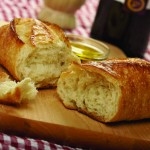 Q: Have you got any reliable tips for making gluten-free and milk-free bread? Most homemade/ machine recipes I’ve tried end up very crumbly and heavy. Ones to buy are very expensive if not on prescription.
Q: Have you got any reliable tips for making gluten-free and milk-free bread? Most homemade/ machine recipes I’ve tried end up very crumbly and heavy. Ones to buy are very expensive if not on prescription.
A: Gluten-free bread doesn’t have to be crumbly or dense if you treat it more like cake batter and add a few extras to help mimic gluten.
Tips to help improve your loaves:
- Gluten-free flours need hydration, so use almost the same quantity of liquid as flour – include any egg as part of your liquid measurement. A good ratio would be 500g dry ingredients to 400g water plus one egg.
- Bread should take time – even gluten-free bread! Try resting your dough overnight to allow the flours to soften and hydrate, before you add the yeast and scrape it into a generously greased and floured loaf tin.
- Choose a mixture of whole grains such as teff, gluten-free oats, sorghum, buckwheat or chestnut, then lighten with a starch or two, such as potato or tapioca. The more starch, the lighter the bread, but the less healthy too. Alternatively, use a commercial gluten-free flour blend and add some ground nuts and linseed.
- Add ingredients that mimic gluten – 25-40g of ground linseed or chia seed or 1-3 tsp of psyllium husk are good alternatives to xanthan gum. An egg will always help to bind and lighten a loaf too. Yoghurt is a good thing to add to a loaf because it will help increase protein content and improve flavour. Resting the dough at room temperature with yoghurt in it will help to remove anti-nutrients that can affect digestion of grains.
OUR EXPERT:
 Naomi Devlin Nutritionist Nutritionist Naomi Devlin is an unashamed foodie, who has been blessed with coeliac disease. After studying native diets around the world, she believes the key to good health is to cook from scratch. Using gluten-free whole grains and sourdough cultures, she teaches people about the possibilities of gluten free grains at River Cottage Ashburton Cookery School, and during bespoke days in her own kitchen. milkforthemorningcake.blogspot.co.uk
Naomi Devlin Nutritionist Nutritionist Naomi Devlin is an unashamed foodie, who has been blessed with coeliac disease. After studying native diets around the world, she believes the key to good health is to cook from scratch. Using gluten-free whole grains and sourdough cultures, she teaches people about the possibilities of gluten free grains at River Cottage Ashburton Cookery School, and during bespoke days in her own kitchen. milkforthemorningcake.blogspot.co.uk
